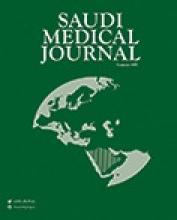REVIEW
Routine detection of carbapenem-resistant gram-negative bacilli in clinical laboratories. A review of current challenges
In Al-Zahrani’s review, several phenotypic and non-phenotypic methods for detecting carbapenem-resistant organisms (CROs) are discussed. However, no consensus has yet been reached with regards to the single most optimal method. Due to differences in carbapenem-resistant activity between carbapenemases, the simultaneous use of 2 or more phenotypic detection methods can improve the detection of CROs compared with a single technique. Molecular methods are currently favored because the majority can be performed rapidly with a high level of accuracy. Whole-genome sequencing (WGS) yields unambiguous data pertaining to complete analysis of the entire genome and may ultimately become a highly powerful tool in routine clinical settings. However, WGS is still relatively expensive and requires an automated data interpretation system. The routine implementation of this technique in clinical laboratories may not occur for several years, particularly in developing countries.
Worldwide distribution of the most clinically important carbapenemase genes (Klebsiella pneumoniae carbapenemase (KPC), New Delhi Metallo-β-lactamase (NDM), and oxacillinase-48 (OXA-48). Carbapenemases listed in white rectangles have been recently recorded.
see page 861
ORIGINAL ARTICLES
The re-awakening of hCG expression. Its role in the diagnosis of cervical squamous cell carcinoma
Bozdag et al compare immunohistochemical detection of Human chorionic gonadotropin (hCG) expression in paraffin embedded tissue of squamous cell carcinomas (SCC) and high grade squamous intraepithelial lesions. The study supports the association of ectopic hCG expression in cancer pathogenesis by demonstrating strong hCG immunoreactivity only in SCC cases. This finding can be helpful in supporting the diagnosis of invasive carcinoma in small or fragmented biopsies, which can on their own be confusing for the pathologists.
IIllustration of immunohistochemical staining for hCG, demonstrating strong expression is related to squamous cell carcinoma
see page 873
Relationship between human leukocyte antigen DRB1 and psoriasis in Iraqi patients
Zalzala et al investigate the role of Human leukocyte antigen Class II DRB1 in susceptibility to psoriasis in Iraqi patients. Zalzala et al conclude that Human leukocyte antigen-DRB1*0102 and *0306 are significantly associated with psoriasis. Human leukocyte antigen-DRB1*1101 is significantly associated with plaque-type psoriasis. Human leukocyte antigen-DRB1*0102 is significantly associated with other types of psoriasis rather than plaque-type psoriasis.
see page 886
CASE REPORT
Bilateral adrenal hemorrhage in antiphospholipid syndrome. Anticoagulation for the treatment of hemorrhage
Alotaibi presents a fatal case of invasive Aspergillus flavus sinusitis in a 43-year old female with sickle cell disease (SCD) complicated by intracerebral aspergilloma and invasive Salmonella infection. Cerebral aspergilloma carries a very high mortality rate. The patient developed post-craniotomy intracerebral hemorrhage at the site of biopsy, Salmonella species sepsis and ventriculitis. She presented with a 2-month history of headache, dizziness, personality and behavioral changes, and vomiting. Initial clinical evaluation raised the suspicion of brain tumor. Brain magnetic resonance imaging revealed a left frontal, thick-walled ring-enhancing lesion with extensive surrounding edema suggestive of a neoplastic lesion, or a contiguous inflammatory or infectious process from the skull base. Despite early diagnosis and appropriate antifungal and surgical management, she eventually died from severe infection and respiratory arrest. In conclusion, invasive aspergillosis should be included in the differential diagnosis of SCD patients with central nervous system (CNS) lesions.
Post contrast administration MRI-Brain
see page 935
- Copyright: © Saudi Medical Journal
This is an open-access article distributed under the terms of the Creative Commons Attribution-Noncommercial-Share Alike 3.0 Unported, which permits unrestricted use, distribution, and reproduction in any medium, provided the original work is properly cited.









